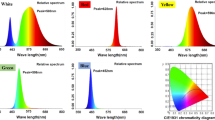Abstract
Exposure of the purple bacteria Rhodobacter sphaeroides MDC6522 isolated from Jermuk mineral springs (Armenia) to extremely high-frequency electromagnetic radiation (51.8 and 53.0 GHz) for 15 min resulted in a pronounced increase in the specific growth rate and H2 photoemission. However, a significant decrease in the specific growth rate (1.6–2.0 times) was observed when the duration of irradiation was prolonged to 1 h. The maximum effect was at a frequency of 53.0 GHz. During irradiation for 1 h, absorption maxima typical of carotenoids gradually disappeared, and the level of bacteriochlorophyll а complexes decreased. Prolonged irradiation also inhibited the H2 production during bacterial growth for 72 h, although it was restored after 96 h of growth. The activity of N,N'-dicyclohexylcarbodiimide-sensitive proton F0F1- ATPase also decreased in Rh. sphaeroides. These results indicate that the membrane-bound F0F1-ATPase may be the main target of action of extremely-high-frequency electromagnetic radiation. The data we obtained can be used in biotechnology for control of growth and hydrogen metabolism of phototrophic bacteria.
Similar content being viewed by others
Abbreviations
- EHF EMR:
-
electromagnetic radiation of extremely high frequency
- ORP:
-
oxidation-reduction potential
- BCHL a :
-
bacteriochlorophyll a
- DCCD:
-
N,N'-dicyclohexylcarbodiimide
References
O. V. Betskii, N. D. Devyatkov, and V. V. Kislov, Crit. Rev. Biomed. Eng. 28, 247 (2000).
D. Soghomonyan, K. Trchounian, and A. Trchounian, Appl. Mirobiol. Biotechnol. 100, 4761 (2016).
H. Torgomyan and A. Trchounian, Crit. Rev. Microbiol. 39, 102 (2013).
S. M. Janković, M. Z. Milošev, and M. L. J. Novaković, Hospital Pharmacol. 1 (2), 102 (2014).
A. Kh. Tambiev, Biomed. Radioelektr. 6, 4 (2014).
A. Kh. Tambiev and N. N. Kirikova, Crit. Rev. Biomed. Eng. 28 (3–4), 589 (2000).
V. Ohanyan, A. Sarkisyan, A. Tadevosyan, and A. Trchounian, Biophysics (Moscow) 53 (5), 406 (2008).
A. Tadevosyan and A. Trchounian, Biofizika 54 (6), 1055 (2009).
H. Torgomyan, V. Ohanyan, S. Blbulyan, et al., FEMS Microbiol. Lett. 329, 131 (2012).
D. Soghomonyan and A. Trchounian, Cell Biochem. Biophys. 67, 829 (2013).
L. Gabrielyan, H. Sargsyan, and A. Trchounian, Microb. Cell Factory 14, 131 (2015).
H. Sargsyan, L. Gabrielyan, L. Hakobyan, and A. Trchounian, Int. J. Hydrogen Energy 40, 4084 (2015).
R. K. Clayton, Photochem. Photobiol. 5 (8), 669 (1966).
Z. B. Namsaraev, Microbiology (Moscow) 78 (6), 794 (2009).
T. Maeda and T. K. Wood, Int. J. Hydrogen Energy 33, 2409 (2008).
X. Hu, T. Ritz, A. Damjanovic, et al., Quarterly Rev. Biophys. 35, 1 (2002).
A. Vasilyan and A. Trshounyan, Biophysics 53 (2), 281 (2009).
L. Gabrielyan, H. Sargsyan, L. Hakobyan, and A. Trchounian, Appl. Energy 131, 20 (2014).
X. Li, Zh.-Zh. Dai, T.-H. Wang, and S.-L. Zhang, Int. J. Hydrogen Energy 36, 12794 (2011).
A. A. Tsygankov and A. N. Khusnutdinova, Microbiology (Moscow) 84 (1), 1 (2015).
L. Gabrielyan, H. Sargsyan, and A. Trchounian, J. Photochem. Photobiol. B: Biol. 162, 592 (2016).
B.-F. Liu, N.-Qi. Ren, J. Ding, et al., Int. J. Hydrogen Energy 34, 721 (2009).
N. I. Sinitsyn, V. I. Petrosyan, and V. A. Elkin, Biomed. Radioelektr. 1, 3 (1999).
Author information
Authors and Affiliations
Corresponding author
Additional information
Original Russian Text © L. Gabrielyan, V. Kalantaryan, A. Trchounian, 2018, published in Biofizika, 2018, Vol. 63, No. 3, pp. 468–474.
Rights and permissions
About this article
Cite this article
Gabrielyan, L., Kalantaryan, V. & Trchounian, A. The Effect of Electromagnetic Radiation at Frequencies of 51.8 and 53.0 GHz on Growth, Pigment Content, Hydrogen Photoemission, and F0F1-ATPase Activity in the Purple Bacterium Rhodobacter sphaeroides. BIOPHYSICS 63, 351–356 (2018). https://doi.org/10.1134/S0006350918030077
Received:
Accepted:
Published:
Issue Date:
DOI: https://doi.org/10.1134/S0006350918030077




